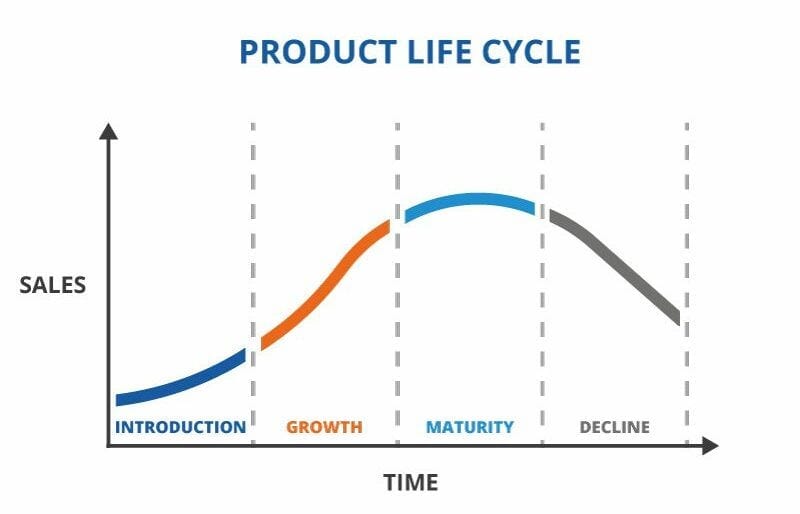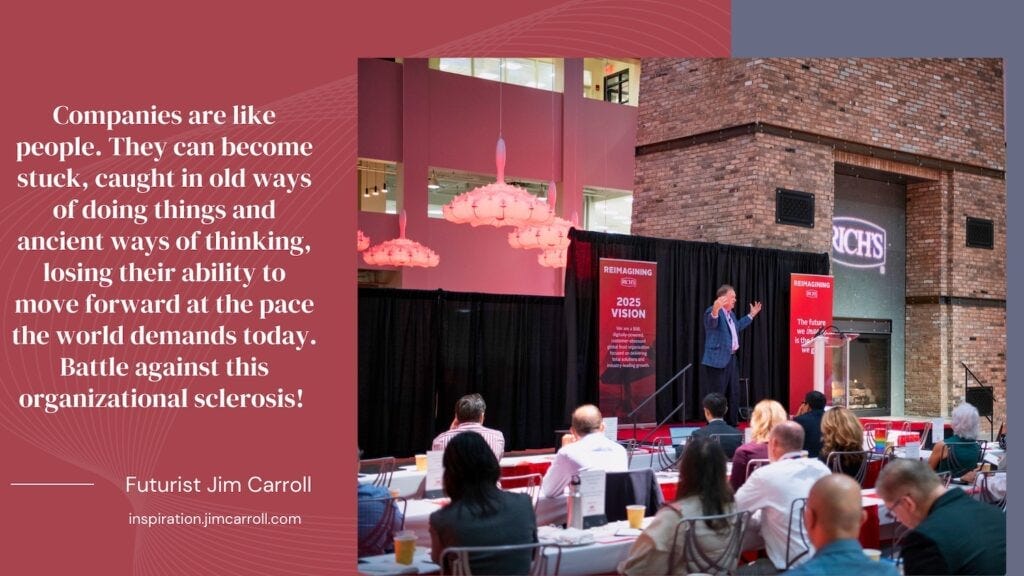Coronary artery disease remains one of the leading causes of death, next only to the loss from the recent anti-science stupidity which has enveloped our world as of late.
But I digress.
In this photo from earlier this summer, I'm on stage for Rich Products, a global supplier of food products; the CEO invited me in for a talk as he brought together his global team for the first time since Covid began. He wanted a message to be emphasized to his team - that everything has changed, nothing is the same, speed is everything, disruption is rampant and innovation is critical. Oh, and that was the case before the pandemic began - except, it's all so much faster now!
Part of the art in these circumstances is working in methods and stories that help people comprehend the pace of change. One way I do this is to challenge them to think about the concept of product longevity, the life of brands, and how our internal culture can hold us back from the pace of innovation with those fast-moving realities.
With that in mind, here's a neat trick -- go dig out your old marketing textbook, and take a look at the chapter on product lifecycles. Essentially, market development, then growth, maturity, and eventual decline. Organizations need to innovate in the context of this age-old reality - what you sell today will be out of date tomorrow, and you'd better have some new products and ideas in your pipeline or you won't survive.

Here's the key thing - lifecycles are collapsing: my university book featured a fridge, and the time access was '25 years.' LOL! Every single product in every single industry becomes older, out of date, irrelevant, ancient, and faster than ever before. That car you bought just last year? It's already from the olden days!
The reality I put in perspective for this group is that food product lifecycles are collapsing and new products need to emerge at a furious pace - food is like fashion, with products coming and going at a ridiculously fast pace. Two slides from my presentation emphasize the point:
- consumers are snacking more frequently - it's now 24% of all “meals”
- in that context, 'snacks are like a fashion category.....People want a change. it's going to be short-lived--maybe a quarter, maybe six months, then changed out” Private Label Buyer
and
- rapidly changing taste : flavours now move from upscale kitchens to chain restaurants to grocery home-cooked meals, in 12 months, compared to 36 months 5 years ago
With that in mind, I had worked on a quote, unknown to the originator who was in the room:
“If something is in fashion this year, you can count on it being different next year, so it really challenges us to stay ahead of the curve and keep thinking of those new ideas to help our customers” - Wendy Barth, VP of Marketing and R&D, Asia Pacific region for Rich Products Corporation
‘Even a niche in China is lucrative’ 15 June 2018, WRBM Global Food
If you aren't innovating, you aren't winning! . Sit back and think about just how ridiculously old-fashioned product longevity is! There are no product lifecycles -- there is just 'agility in time to market.' That was my first key message - followed by 'what barriers do you have in the way of innovating quickly? Are you stuck?' My role in these circumstances is to challenge the audience to think about their speed - and the internal cultural barriers they might have around 'moving fast.' When thinking about innovation and the future, and your ability to stay ahead of the innovation curve when it comes to what you do, and how you do it, ask yourself these questions:
- do you know the rate of change -- the velocity of change -- that impacts you, your industry, and your products?
- are you meeting the requirement for operational excellence that your customers, suppliers, business partners and everyone else expects of you - and recognizing that post-pandemic, those expectations are higher?
- are you properly positioned for velocity, in terms of your agility to do things at the pace required?
- does your culture support high-velocity change, or are you almost keeling over from organizational sclerosis?
- do you have the feedback and innovation mechanisms in place to deal with high-velocity change, and can you learn from them?
- are you planning at the leading edge, or are you still reviewing what you were planning last week?
- are you evolving markets/products at the pace required, or are your customers marching on because you are stuck in a slow time-to-market rut?
- are you at the curve of expectations of customers' needs -- do they think you've got the right stuff when it comes to velocity?
- are you anticipating customer solutions before they know they need them?
I know I talk about speed a lot - but the thing is, it's what the CEOs of my clients are asking me to focus on. They see it as critical to their survival, and are seeking validation of their message with someone who can spin this story from the stage!

